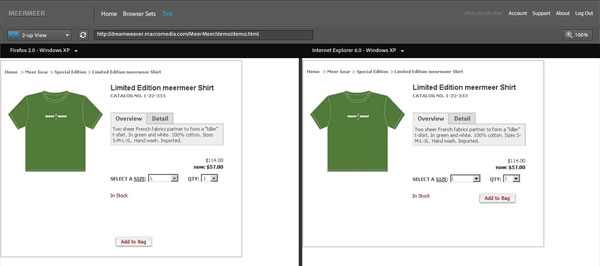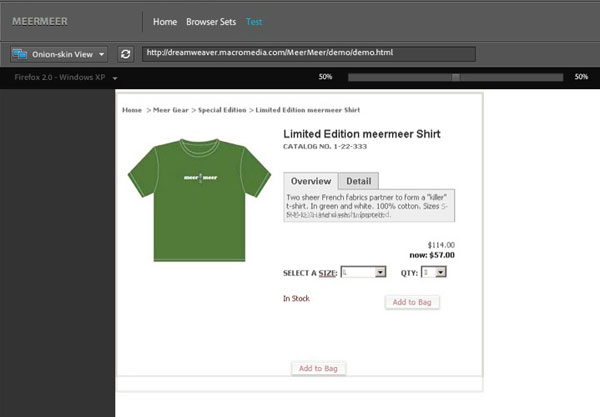 Each year at their annual MAX event, Adobe shows off some of their most compelling projects during the “Sneaks” keynote. At the 2007 conference, the most talked about sneak was “Thermo,” recently made official as Flash Catalyst. This year, the honor of coolest upcoming project at Adobe might go to Meermeer, a new cross browser testing tool that will completely make Browsershots.org obsolete.
Each year at their annual MAX event, Adobe shows off some of their most compelling projects during the “Sneaks” keynote. At the 2007 conference, the most talked about sneak was “Thermo,” recently made official as Flash Catalyst. This year, the honor of coolest upcoming project at Adobe might go to Meermeer, a new cross browser testing tool that will completely make Browsershots.org obsolete.
Meermeer, which is set to debut as an online service and Dreamweaver CS4 extension on Adobe Labs sometime next year, is a cross browser web site testing tool that will be delivered as a service. I was able to get a demo of Meermeer today from Adobe Senior Product Manager Devin Fernandez and Product Manager Scott Fegette.
Fegette told me that when Adobe asked developers to name the biggest pain point when developing web sites, an overwhelming majority of respondents told them that cross browser testing was a major headache. For most developers, testing cross browsers and operating systems is a clumsy process involving multiple machines, screenshots taken by friends and emailed, and waiting on slow web sites like Browsershots.org.

Those methods generally require developers to actually publish a web page and then point a service (or friend) at the live page to test in various browsers. Meermeer simplifies the process by letting developers send local code to the Meermeer server and almost instantly receive back screenshots of that page rendered in different browsers and on different operating systems, with no need to go live with the code. The code can be set to be sent automatically from Dreamweaver (similar to the preview in browser view) and Meermeer can stay synced with the latest version of the code — so you can get continuous updates on how your code looks cross browser as you tinker with it.
Unlike Browsershots.org, Meermeer doesn’t use a batch processing method to serve up screenshots. Rather, the site scales as needed by deploying more virtual machines to take site screen shots, which means there will never be a long wait time to receive test results, and adding additional browsers and operating systems is simple. At launch, the service will support a “core” set of browsers based on those in use most by end users around the web, including Internet Explorer 6 and 7, and Firefox 2 and 3 on Windows, and Firefox 3 and Safari on Mac.

Another helpful innovation Meermeer adds is the ability to view browser tests via multiple views. In addition to the standard 1-up, and 2-up (side-by-side) views, Meermeer has an “onion skin” view that overlays one browser screenshot on top of another. Developers can adjust the opacity on each shot with a slider so they can pin point differences. As you can see in the screenshots above, this might be the first time in history that IE is rendering a page more correctly than Firefox (Fegette’s joke, not mine!).
Fegette told me that the onion skin-type overlay view is something that developers were already doing for testing purposes using manually created screenshots and Photoshop. So adding that functionality to Meermeer was natural and simplifies the process for developers.
For now, Adobe is focusing on pushing Meermeer out the door as a web service and accompanying Dreamweaver extension. Eventually, the company might look into offering an API for the service so that other applications could add Meermeer testing functionality, but there are no concrete plans for that at present. Fernandez told me that nothing precludes them from taking that route though, and we shouldn’t count it out as a possibility.
When I asked where the rather unusual name “Meermeer” came from, Fernandez told me that the original name for the application was “Mirror Mirror,” as in “Mirror, mirror on the wall,” but after saying it over and over, it was eventually shortened and the meerkat became the unofficial mascot for the app. Hence, Meermeer.
 Josh Catone
Josh CatoneBefore joining Jilt, Josh Catone was the Executive Director of Editorial Projects at Mashable, the Lead Writer at ReadWriteWeb, Lead Blogger at SitePoint, and the Community Evangelist at DandyID. On the side, Josh enjoys managing his blog The Fluffington Post.
